COSTA RICA Part 3 – Caribbean Pura Vida Continues
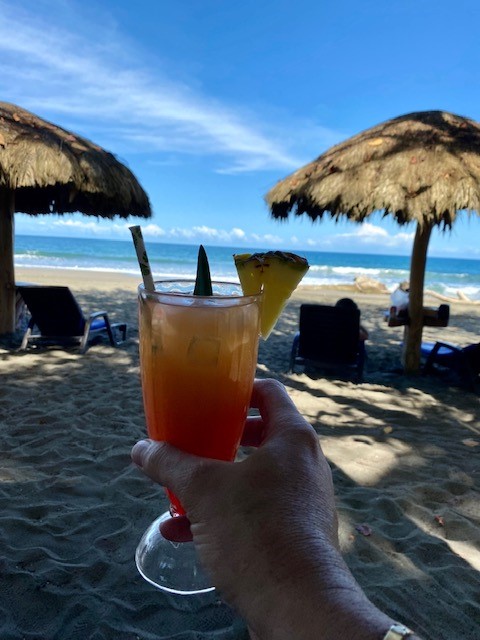
“Have you ever noticed that anybody driving slower than you is an idiot, and anyone going faster than you is a maniac?” – George Carlin
On the road again … we came zigzagging down from the highlands to the Caribbean, driving through lush mountain forests, and with banana, pineapple and sugar cane plantations flanking both sides of a two-lane highway, we’d encounter plenty of idiot, maniacal drivers.
But with the superb scenery, it didn’t matter much to us – for we’ve been “Pura-fied” by now and enjoy the general slow pace of Costa Rica. After six-hours, 207km (129 mi), we reached the Caribbean side and the New Castle finca of Linda and Errol, our hosts. Though not yet named, we dubbed it Finca ErroLinda.
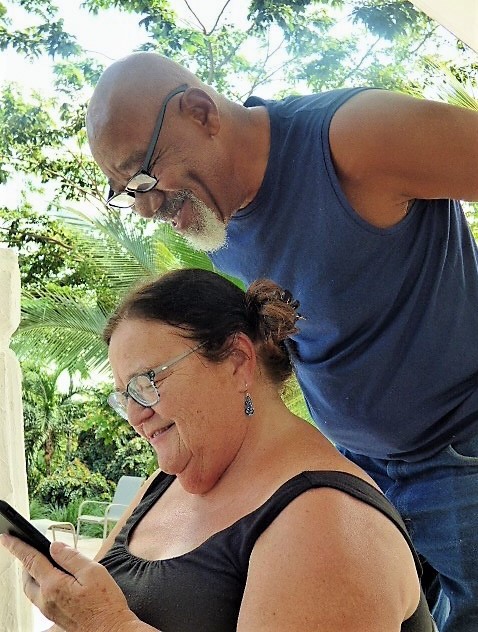
Their house sits on the highest point on their large property; with the Caribbean in view through the vast array of fruit trees, wild vegetation and an abundance of wildlife and birds. The finca used to be a cacao farm, but sadly, a disease known as Frosty Pod Rot, or more formally called Moniliasis, decimated the farm and it never recovered. Linda and Errol call themselves pioneers, but to me it seems that they live pretty much off-the-grid except that their WiFi’s a lot better than the hotel in San José.
The farm is reached by a partially unpaved and very bone-jarring road. And just before we reach the last turnout, Linda mentions that this part is what she calls a leap of faith – the road dips down to a steep angle, plunges into a ravine, then, driving up to the other side, you land at the portico of their garage – and you’ve arrived.
After the long day’s drive, Linda was pretty wiped out, but still managed to whip up a wonderful Caribbean dinner of black beans and coconut rice, and fish in a coconut tomato sauce – note to self, I must get the receta or at least a list of ingredients. There was also chicken in a light garlic, coconut sauce, a salad of tomates, onions and cucumbers (a mainstay of my Cuban roots). After dinner we hung out on the porch and shared stories.
Linda was telling us about a large, brown toad that her grandchildren have named Toady. He’s a local character that loves to get inside the house, especially our room – and to my surprise he was indeed waiting for me at the door when retiring for the night. The suddenness of Toady’s appearance took me by surprise; and quickly went back to the main house yelling for Linda, “Toady’s trying to get in!” She brushed him gently away with a broom. I know the old wives’ tales, “touch a toad get warts” or “kiss a frog to find your prince.” Neither doing, so the broom sweep worked. Overnight the little devil had fallen into the pool. This morning I rescued him, so now we’re pals for life.



The morning brought out nature’s symphonies of sound as Rita and David kept themselves busy as bees pointing their camera at the fauna and flora surrounding the house; like two kids in a candy store. These two early birds would eventually be rewarded after staring, patiently waiting, and watching as birders need to do. All I kept thinking was, “Look! Up in the sky! It’s a bird! It’s a plane! It’s Superman!” In their case, it would be a toucan or parrot.








Suddenly, birdsong choruses would erupt and would immediately excite them; frantically searching for where the singing was coming from. Toucans squawking! Parakeets chirping! Green Mealy Parrots shrieking! Montezuma Oropendolas yodeling! A great cacophony thisaway – thataway.
I had my Kellogg’s Froot Loops’s, Toucan Sam, in-the-flesh moment with a trio of dazzling toucans appearing bright and early, beginning their day loudly communicating with one another. I saw my first chorus perform high up in the treetops and they were magical majestic creatures. In Costa Rica, there are six species of toucan; here we saw two: Rainbow-billed and Black-billed, in Spanish they’re known as Dios-te-de (g-d gives you) because it sounds like that’s what the birds are saying when they call each other.






The fascinating, colorful, odd-looking and sounding big bird, the Montezuma Oropendola (say that fast three times!), have a colony on Errol and Linda’s property overlooking the pool. There are upwards of 30 nests hanging from just a few trees and all built entirely by the females! They’re feats of engineering in their long teardrops hanging precariously high off the ground from thin branches extending way out from the tree trunk. The birds feed their hungry, vocal chicks throughout the day; all meanwhile squawking loudly; Linda calls the birds, the Yodelers!


*** Linda sent us this fascinating update to the hanging bird colony:
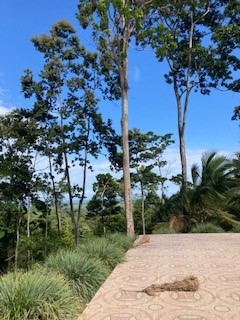
“When the fledgling Montezuma Oropendola birds have hatched and flown away, the nests are snipped off and down they come!”
Morning Costa Rican coffee on the terrace brought back vivid memories from my childhood in Cuba. Linda prepared it in a simple and inexpensive, clever contraption called a sock or to us Cubans, a “Teta.” This method has been used for a very long time in countries like Mexico, Singapore, Malaysia, Thailand, Indonesia, and Costa Rica. It’s hard to say where the method originated, but it’s easy to imagine the idea came to a lot of people separately in different places.
Time for some fun in the sun at the beach! After breakfast, we drove about 30 miles down the coast to the laid-back tourist town, Puerto Viejo (Old Harbor), close to the Panamanian border. We had two days stay at the Banana Azul resort, “Where Jungle Meets the Caribbean.” https://www.bananaazul.com/ … the plan is plenty of drinks with umbrellas accompanied by hammock and beach time.
The resort sits a short 50-meters from the lovely, black sand beach, Playa Negra. Costa Rican law reserves all beaches as public property; so, a 50-meter-wide strip of the beach must exist between the high tide line and the outer line of the private property; then the next 150-meters of beachfront is given as a concession; lasting between 5-20 years, so basically, you don’t own the land.






Puerto Viejo is filled with young people searching for a more budget-friendly Costa Rica. You could say that the town also has a hippy-dippy, Rastafarian vibe, along with surfer dudes – CR’s biggest, most powerful wave is located here.
We did get up out of our beach chairs and rented Ebikes for the day. It was great fun zipping along into town for a little retail therapy; continuing out on the curvy, narrow road for a bit of sightseeing, cutting loose now and then. David’s now in love with Ebikes. To him, it beats the wild ATV adventure we had back home.
Banana Azul’s dinner menu had a tempting seafood menu: appetizers of plantain cups filled with a variety of seafood, fresh-fried grouper, and David’s mahi-mahi in a savory ginger soy sauce hit it out-of-the ballpark with its flavors. Desert: mini-coconut flans and lime pie, about two bites each, perfectly capping a tasty meal. A delicious after-dinner digestif followed, Flor de Caña, a premium, full-bodied rum made next door in Nicaragua. It was so good, David picked up an aged 18-year-old bottle at Duty-Free for a good price.






It’s been a wonderful two days beachside; being coddled by Mother Nature … the lull of crashing waves welcomes our sleep, and a cacophony of birds awakes us from our slumber (a morning’s ritual everywhere).
On the drive back to the finca, we happened upon a two-toed sloth slowly walking on the side of the road. Traffic was stopped as people jumped out of their cars and gawked. Of course, we did, too. Spotting a sloth was a top priority and here it was in the wild. I jumped out of the car and came face-to-face with the sweetest face. Sloths are almost helpless on the ground and can be ferocious when under attack. However, knowing that if he tried to attack, I’d easily outrun him. Btw … a local picked him up by the scruff of his neck and placed him back inside the roadside jungle.
Gotta love these drowsy tree-dwellers – they sleep up to 20 hours a day! And even when they’re awake, they barely move at all. In fact, they’re so incredibly sluggish, algae actually grow on their fur (providing them camouflage up in the trees). They can be 2 to 2.5 feet long and, depending on species, can weigh from 8-17 pounds.
There are two main species of sloth; identified by whether they have two or three claws on their front feet. The two species are quite similar in appearance, with roundish heads, sad-looking eyes, and facial coloring that makes them look like they’re always smiling. We were certainly smiling having finally experienced a sloth encounter!
We returned to the farm for a final night. David and I are cooking dinner for our hosts tonight: shrimp in a rich tomato sauce infused with paprika, sweet peppers (red, yellow, green), and Spanish olives; along with a bountiful salad. Linda made another version of her rice and black beans in coconut sauce. It was a savory, delicious meal that we all devoured. Dare I say it again … Pura Vida, folks!

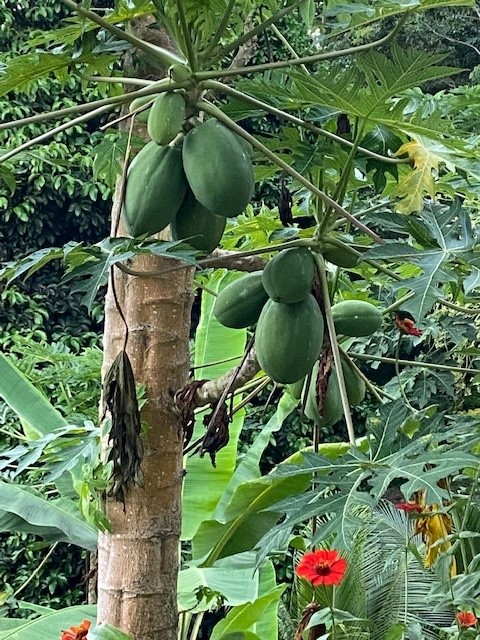


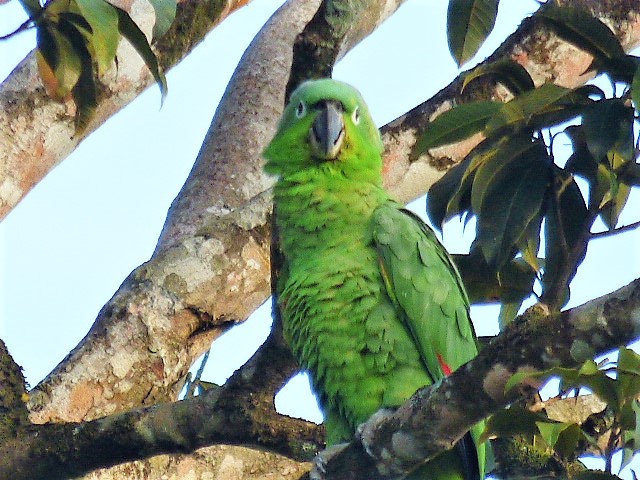
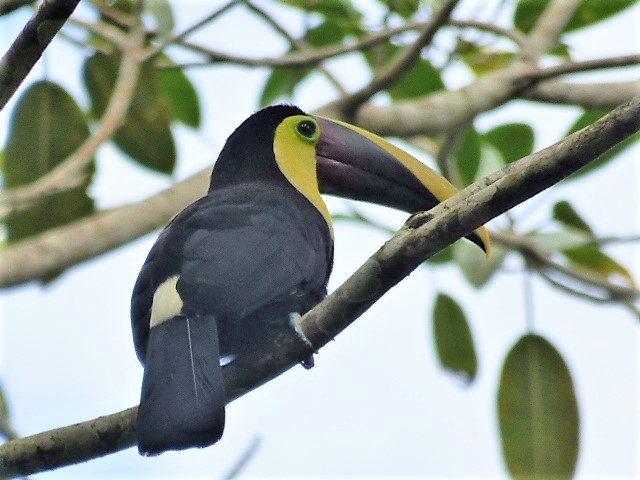

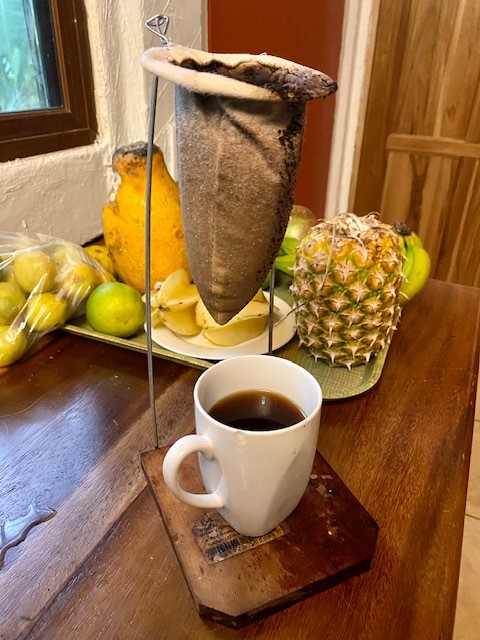



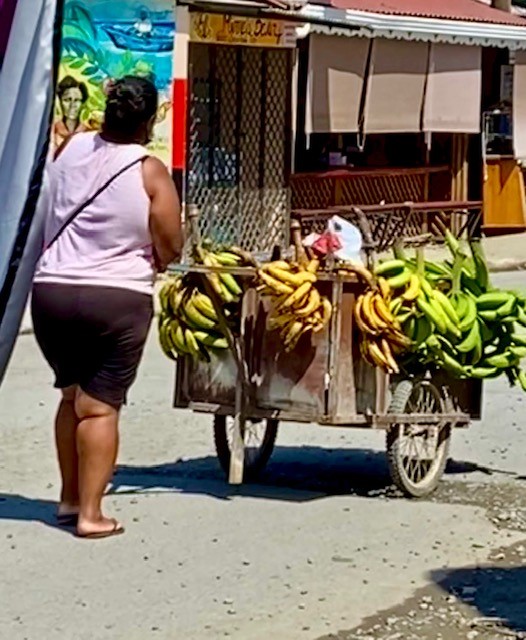

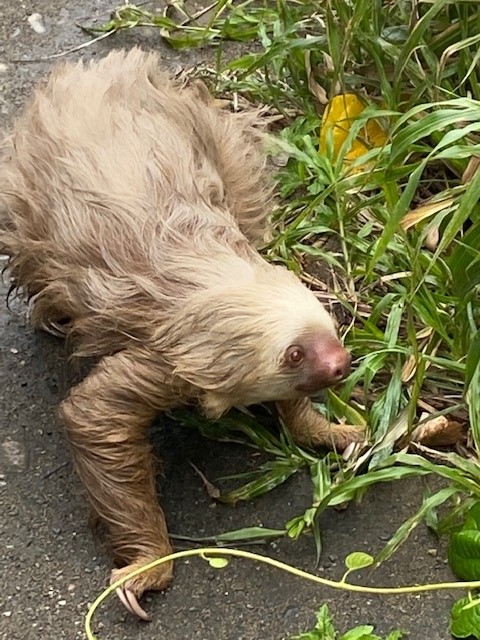
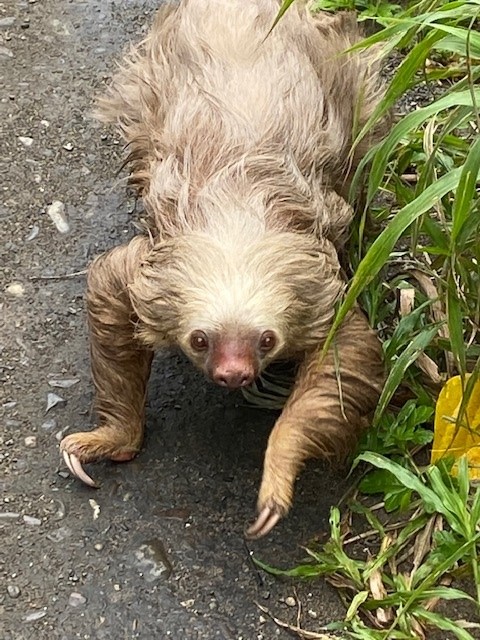



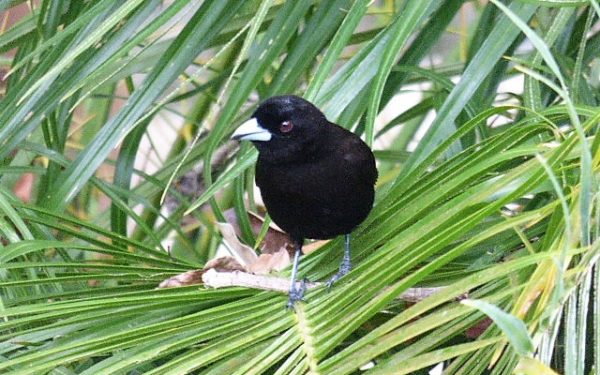
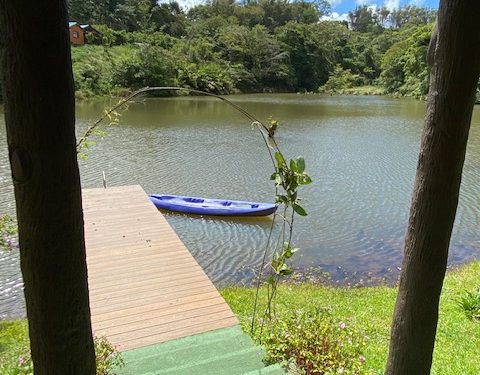
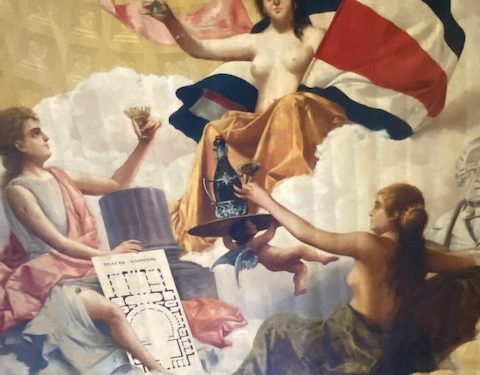
What a fantastic adventure, complete with beautiful birds, a friendly toad, and a sloth encounter! I am so jealous! It’s wonderful hearing from you guys. Take care.
Gorgeous pictures! It looks like a great vacation.
Hi! Its Linda, Im on a long wait here in Houston, traveling from Costa Rica to Minnesota, being duly entertained by the memories of what I refer to as “ The Costa Rica Sampler”. It was an extravaganza of driving the roads, the food, the birds, the ocean, the beautiful camaraderie, the rasta pura vida of the Caribbean coast! Much love to my fellow sojourners, life is but a dream😋
This was an amazing interesting read. Love all the photos and narrations. Thank you so much. Sharon
I so enjoyed all of your adventures! The photos were amazing and I was especially touched by the photos of the sloth.